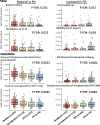Metagenomics of the Gut Microbiome in Parkinson's Disease: Prodromal Changes
- PMID: 37314861
- PMCID: PMC10538421
- DOI: 10.1002/ana.26719
Metagenomics of the Gut Microbiome in Parkinson's Disease: Prodromal Changes
Abstract
Objective: Prior studies on the gut microbiome in Parkinson's disease (PD) have yielded conflicting results, and few studies have focused on prodromal (premotor) PD or used shotgun metagenomic profiling to assess microbial functional potential. We conducted a nested case-control study within 2 large epidemiological cohorts to examine the role of the gut microbiome in PD.
Methods: We profiled the fecal metagenomes of 420 participants in the Nurses' Health Study and the Health Professionals Follow-up Study with recent onset PD (N = 75), with features of prodromal PD (N = 101), controls with constipation (N = 113), and healthy controls (N = 131) to identify microbial taxonomic and functional features associated with PD and features suggestive of prodromal PD. Omnibus and feature-wise analyses identified bacterial species and pathways associated with prodromal and recently onset PD.
Results: We observed depletion of several strict anaerobes associated with reduced inflammation among participants with PD or features of prodromal PD. A microbiome-based classifier had moderate accuracy (area under the curve [AUC] = 0.76 for species and 0.74 for pathways) to discriminate between recently onset PD cases and controls. These taxonomic shifts corresponded with functional shifts indicative of carbohydrate source preference. Similar, but less marked, changes were observed in participants with features of prodromal PD, in both microbial features and functions.
Interpretation: PD and features of prodromal PD were associated with similar changes in the gut microbiome. These findings suggest that changes in the microbiome could represent novel biomarkers for the earliest phases of PD. ANN NEUROL 2023;94:486-501.
© 2023 The Authors. Annals of Neurology published by Wiley Periodicals LLC on behalf of American Neurological Association.
Conflict of interest statement
Potential Conflicts of Interest:
CH serves on the Scientific Advisory Board for Seres Therapeutics and Empress Therapeutics, who manufacture products that may be affected by this study. The remaining authors have nothing to report.
Figures








Comment in
-
Early microbiome changes in neurodegenerative disease.Nat Rev Neurol. 2023 Aug;19(8):458. doi: 10.1038/s41582-023-00848-5. Nat Rev Neurol. 2023. PMID: 37402802 No abstract available.
References
-
- Kalia LV and Lang AE, Parkinson’s disease. Lancet, 2015. 386(9996): p. 896–912. - PubMed
-
- Dehay B, et al. , Alpha-synuclein propagation: New insights from animal models. Mov Disord, 2016. 31(2): p. 161–8. - PubMed
-
- Holmqvist S, et al. , Direct evidence of Parkinson pathology spread from the gastrointestinal tract to the brain in rats. Acta Neuropathol, 2014. 128(6): p. 805–20. - PubMed
-
- Svensson E, et al. , Vagotomy and subsequent risk of Parkinson’s disease. Ann Neurol, 2015. 78(4): p. 522–9. - PubMed
Publication types
MeSH terms
Grants and funding
LinkOut - more resources
Full Text Sources
Medical

